Starting Over
We flew from Penang to Phuket, not a very long flight. As we approached the airport in Phuket the jutting verdant islands of South central Thailand stood out. Already I had the sense we were going somewhere quite different from where we had been so far.
We spent 4 months absorbing the similar languages of Bahasa Indonesia and Bahasa Malaysia, which were relatively easy for picking up simple phrases, greetings and food vocabulary. It helps that the characters are in Latin alphabet, and also many people speak English.
Thai language seems to have very few cognates with the Malay languages. The Thai characters are completely different and quite confusing to the ignorant foreigner. The spoken language has different intonations and many sounds not found in the English (or Japanese). So getting to the basics of greetings and food vocabulary took a little longer. Nor did we practice any of these basics before getting to Thailand. Straight off the plane I went straight to an exchange counter to get some Thai baht, and realized at the end of the transaction that I had no idea how to say the most important phrase in Thai — Thank You.
Phuket
 View of Eastern Phuket
View of Eastern Phuket
Phuket is a large peninsula that hangs off the western coast of Thailand into the Indian Ocean. All along the coast It has many beaches crowded with resorts and hotels. We stayed in Kata Beach, almost an hour drive south from the airport, and one of the busy beaches though not as crazy as Patong. But really we came to Phuket to have some time at the beach. We were based in Kata Beach, which wasn’t bad. One evening when the tide was super low you could walk out 50 meters from the high tide mark. Going up and down the coast there are lots of beaches to explore some quite small and relatively remote.
As far as we could tell all of Phuket was overrun with Russian tourists. Presumably this is because Thailand (and parts of Vietnam) have the closest cheap beach destinations from Russia. Going to the beach in Kata we were literally surrounded by Russians, young couples, old couples, small families, large families. But there were tourists from other parts too, Italian, French and some Chinese, Korean and the occasional American couple. It was a constant reminder that Thailand has embraced the tourism industry. The density of tourism in Phuket was unlike anything we experienced since being in Canggu, Bali.
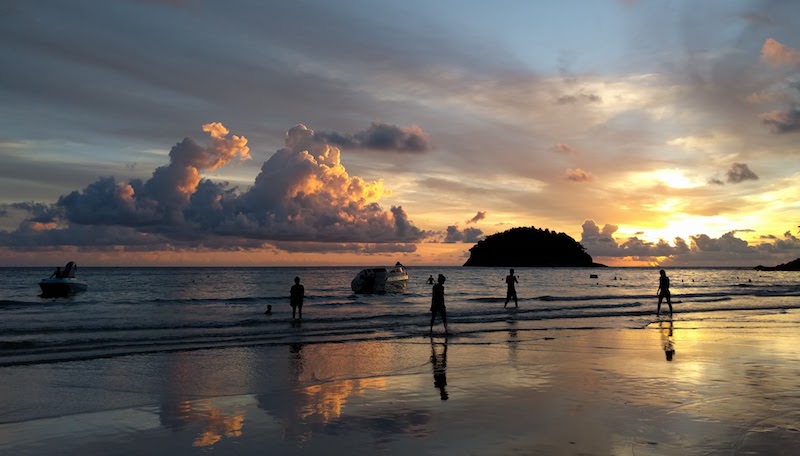 Sunset at Kata Beach
Sunset at Kata Beach
This made it a more expensive part of our trip. We spent 2 weeks in Phuket, staying in a condo rental about a 15-20 minute walk to the beach. Luckily we had a decent kitchen and found some good items at the two local markets. We also discovered, away from the beach, the main road with a stretch of restaurants and shops more frequented by locals.
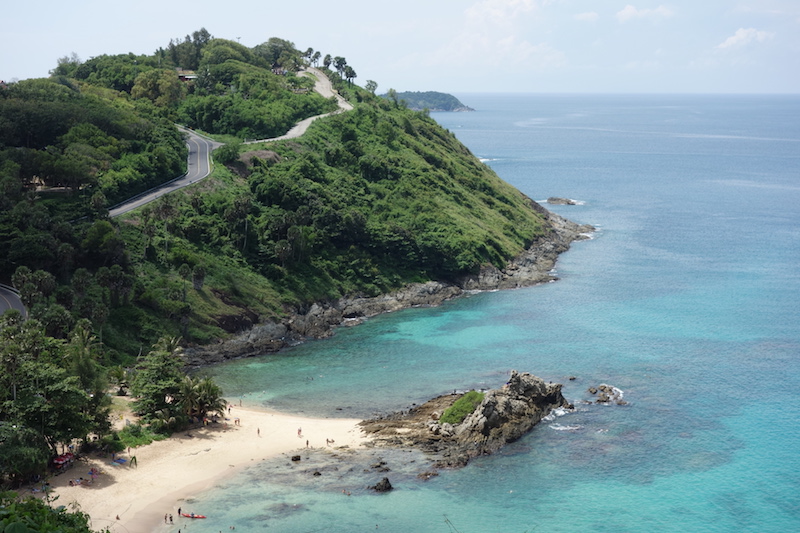 Yanui Beach south of Kata
Yanui Beach south of Kata
Something we ate…
One day we bought some raw chicken at the market and I cooked it the next day for dinner but probably not enough — that’s our best theory about what led to 24-hours of soul-draining food poisoning. It started about 12 hours after eating the dinner, and Kanako and I soon found ourselves increasingly unable to eat much of anything, much less stay in any position but horizontal, unless it was on the toilet. Quite luckily, Asa managed to avoid the food poisoning altogether (he didn’t eat more than a bite of the chicken). But we still needed to make some effort to take care of him while we could hardly take of ourselves. We managed to make some leftovers for lunch and then I tumbled down the street to get some takeout at a restaurant, and I made sure to get only non-spicy food.
I’ve had worse stomach problems before, but this one, because of the mild accompanying fever, was pretty exhausting. By the next morning we were pretty functional. Not until the following day were we 100%, and to continue our recuperation we took a motorbike ride outside Kata up to the newly built Big Buddha Phuket, visible from most parts of the southern peninsula. Signed charms of various sorts are often hung near temples for good luck or more specific wishes.
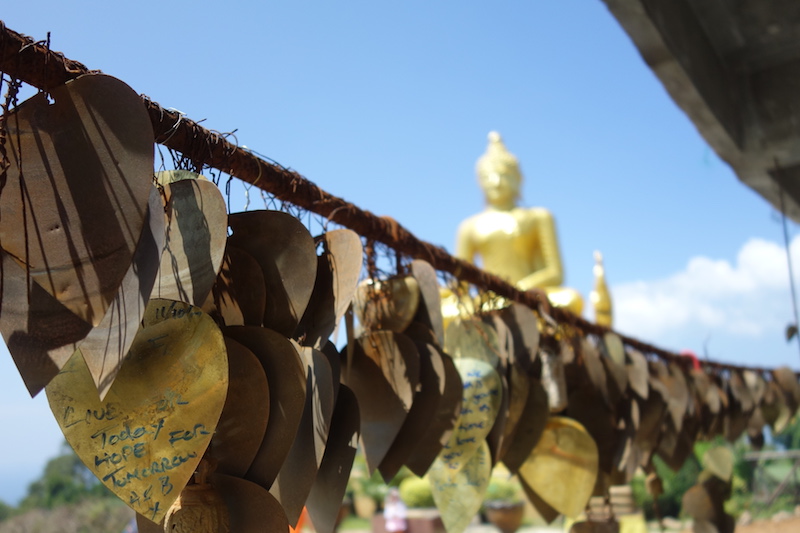 Signed charms near the Big Buddha
Signed charms near the Big Buddha
The Kings: Cremation Ceremony
Soon after arriving in Thailand we started recognizing the ubiquitous portraits of middle-aged man in glasses, usually with a very slight Mona Lisa smile — King Bhumibol Adulyadej the Great, also known as Rama XI. The portraits can be found everywhere from the airport terminals, to public squares, inside almost every single restaurant or business establishment in Thailand. Also, before every major event (including in movie theaters before the show starts), the Thai Royal Anthem is played with everyone standing (and singing). This is not to be confused with the Thai National Anthem that is played every day in public spaces at 8am and 6pm.
The king reigned for roughly 70 and a half years — Thailands longest reigning monarch, and at the time the world’s longest reigning head of state. October 2016 he died at the age of 88. For a full year Thailand prepared for a massive cremation ceremony held in October 2017 while we were in Phuket. On the day of the final ceremony all cable TV networks were shut down, and regular TV stations broadcast either footage of the ceremony or historical footage of the kind throughout his life. Footage of the ceremony showed thousands of mourners, seemingly average Thai citizens dressed in black lining up all day in the hot sun to pay their respects and for their chance to place specially prepared flower offerings. (A good NY Times article about the ceremony.)
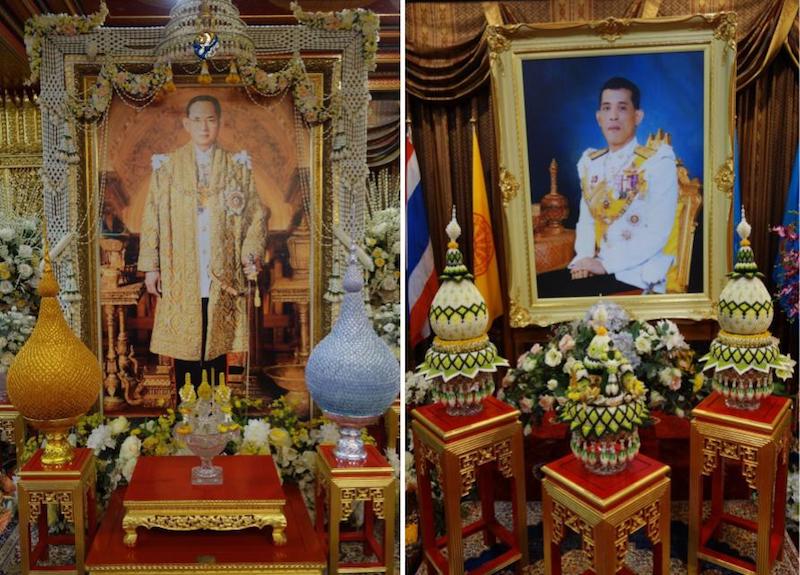 King Rama IX and King Rama X
King Rama IX and King Rama X
Thai people are very serious about their king, and I do not know all the reasons for his popularity, but the clear devotion itself was impressive. The King was succeeded by his only son, Maha Vajiralongkorn Bodindradebayavarangkun (actually see the full name here), now given the title Rama X. The new king is not as revered and has had some scandals over the years. Still, he is the king, and special laws specifically prohibit any criticisms of the royal monarch. His portrait now is coming up all over the place, no slight smile on his portrait only a hollow look, perhaps showing the weight of his position to retain the love of his people if not their respect and loyalty.
Though, it was not a very long time, it was time to say selamat tinggal (goodbye in Malaysia Bahasa, same as Indonesian) to Malaysia, and sà wàt dii kráp (hello, in Thai). Though I won’t miss the oppressive heat or mosquitoes, I was really glad to spend some time exploring the place calling itself the ’essence of Asia’. It was time for a new place, nearby but very different.
Quick stats
- 3 weeks
- 8 accommodations: 1 apartment, 2 guest houses, 1 homestay
- 2 places: Kuala Lumpur; George Town and Ayer Itam in Penang
- 2 airports: Kuala Lumpur and Phuket (also a train and ferry)
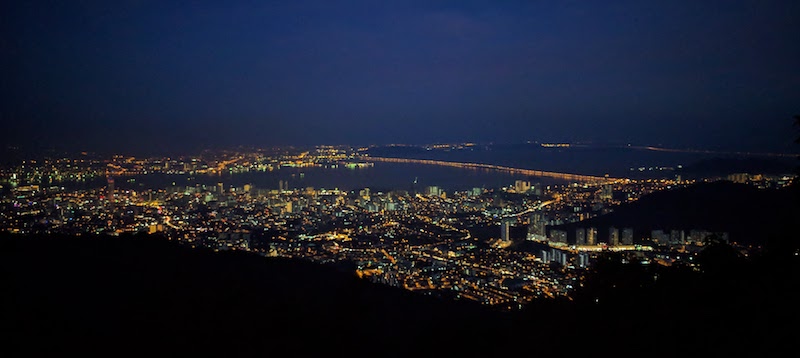 Night falls on Penang
Night falls on Penang
After we got our visas, we moved to an Airbnb homestay in Ayer Itam (or Air Itam), closer to the center of the island and flanked by low mountains. The weather was just as hot, but the surroundings were calmer and greener. We were close to Kek Lok Si, probably the most famous Buddhist temple on Penang. It actually consists of an extensive complex of temples that extend up into the low mountains. It is known for its famous lofty pagoda tower featuring a combination of Burmese, Thai and Chinese Buddhist architectural styles.
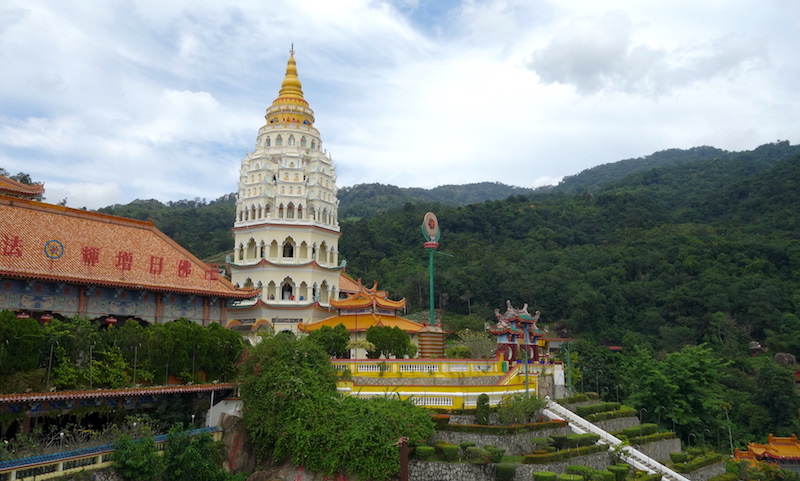 Pagoda tower at Kek Lok Si
Pagoda tower at Kek Lok Si
The complex also has a humongous statue of the goddess Guanyin (Kuan Yin, one of the bodhisattvas of Mahayana Buddhism).
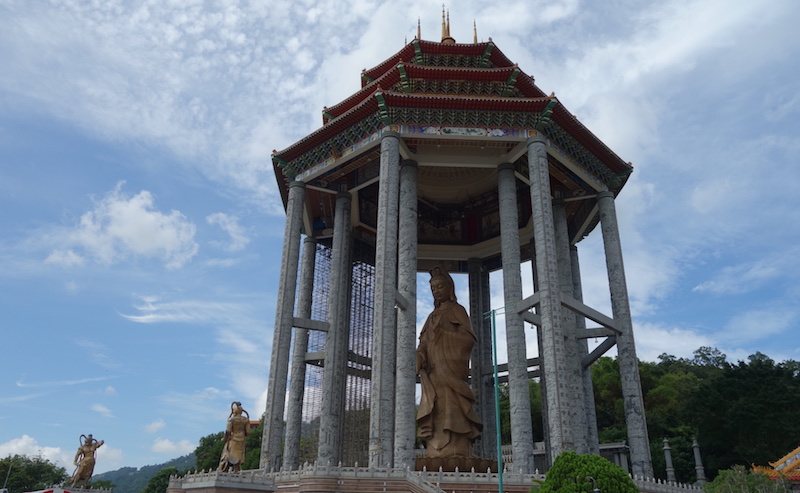 Guanyin statue tower at Kek Lok Si
Guanyin statue tower at Kek Lok Si
Ayer Itam is also close to Penang Hill, a park resort with a famously scenic view of George Town and the channel. To get up there you can either hike 1-2 hours or (like everyone) you take the somewhat historical railway (a funicular railway). The line for the train was endless, which is why some people pay double price (80 RM = $20, one way) to skip the line. We went late in the afternoon on a weekday and ended up waiting almost an hour to go up, and after the sunset waited over an hour to get down.
 View from Penang Hill
View from Penang Hill
Penang Food
Any description of Penang would incomplete without examining the food. But food is probably the main attraction to Penang for foreign tourists and other Malaysians. Compared to KL, Penang appeared to be more inhabited by Malaysians of Chinese descent and Hakka, with a smaller Muslim population than Kuala Lumpur. (Unlike in Kuala Lumpur and much of our time in Indonesia, we only rarely heard the Muslim call to prayer in Penang.) Along with those mentioned there is also the traditional Malaya influences, and a significant community of Malaysian Indians. All this makes for a delicious combination. Though KL is probably about as diverse something about Penang has brought more of these flavors out to commingle.
The best eating venues to experience the combination of tastes are at Hawker stalls — these are small vendors that prepare food at small 1-2 person kitchen stalls. They are usually grouped together in very informal settings (food courts, sidewalks, or alleyways) so you can sit in a common eating area while sampling dishes from a variety of Hawkers.
Here are some of the popular dishes we tried…
- assam laksa - heavy spicy sour fishy broth (made with shrimp paste and tamarind) with rice noodles and other various toppings
- hokkien mee - heavy spicy fishy broth (usually made with prawn shells, and ) often served with a combo of rice noodles and egg noodles and maybe some chunks of chicken and fish. Usually when it is served a soup spoon is placed in the bowl filled with fishy chili sauce so you can make it as spicy as you like
- char koay teow - flat noodles stir fried with sprouts and greens, and the specialty is to have it fried with duck egg
- popiah - like an un-fried spring roll with sweet jicama, tofu, chili sauce and a sweet soy sauce
- rojak - Do you like fruit, squid and chili pepper together? This one is for you — spicy, fishy, salty, and sour all at the same time. Mango, mountain apple, jicama, crispy fried tofu, squid topped with sauce made from palm sugar, peanuts, shrimp paste and sweet chili sauce. Not my favorite, but definitely worth trying.
Outside of Hawker stalls, an important component of Penang flavor can be found at Indian-Malaysian restaurants serving nasi kandar. This is basically buffet-style food of fish curries, mutton curries, korma, biryani, chana and some places had tasty chapati made right in front of us. Some intense flavors, much of it’s spicy, and most of it’s quite delicious.
But we were so busy enjoying all our food that we didn’t take any pictures of it.
After leaving Sumatra we spent a few mostly uneventful days in Kuala Lumpur. Then we took the train up north near the border with Thailand. For four hours, we passed a mostly flat terrain with an endless sea of trees. The train was pretty quiet with few passengers though there was a movie (Eddie the Eagle) being played on a 20 minute loop, annoying me a little too much. Technical difficulty or deliberate?
Our destination was Penang Island — the train only goes as far as Butterworth, just across the channel.
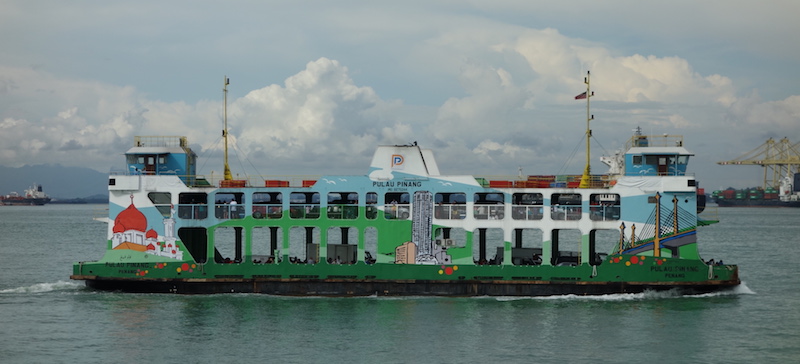 Ferry from Butterworth to Penang
Ferry from Butterworth to Penang
From Butterworth there are two bridges to Penang, and taxis were eagerly offering to take us but we promised Asa we would take the ferry. So from the train station we walked along a confusing series of ramps, up and down stairs and made our way to the ferry terminal. The ferry ride was short and gave us a view of Butterworth, an industrial shipping hub for the region, not so picturesque. Immediately on the Penang side the heat and humidity of the afternoon seemed to bear down. During our 10 days in Penang, the highs were mostly around 34 C (93 F), and hovering around 90% humidity.
Georgetown
We first spent a few nights in George Town, the urban center of Penang and (obviously) eponymously former British colonial town, and also after Kuala Lumpur is the most populous city in Malaysia. The old center of the town is a UNESCO World Heritage site due to its collection of historic landmarks and architecture: colonial, post-colonial and early 20th century Asian architecture styles.
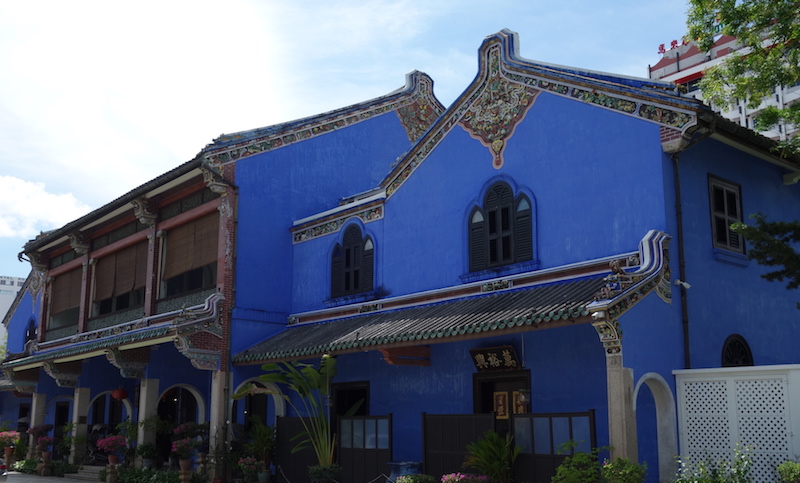 Cheong Fatt Tze (Blue Mansion) in George Town
Cheong Fatt Tze (Blue Mansion) in George Town
But we stayed in George Town to be close to the Thai embassy to get our 60-day tourist visas. So we had some time to explore. The beachfront was under some kind of restoration with large construction vehicles moving around sand and digging channels. It was smelly and couldn’t have been more uninviting. With the industrial hub of Butterworth just on the other side it’s hard to say how nice the beach will be after the restoration is complete.
Just around the block from our guest house were two famous Buddhist temples:
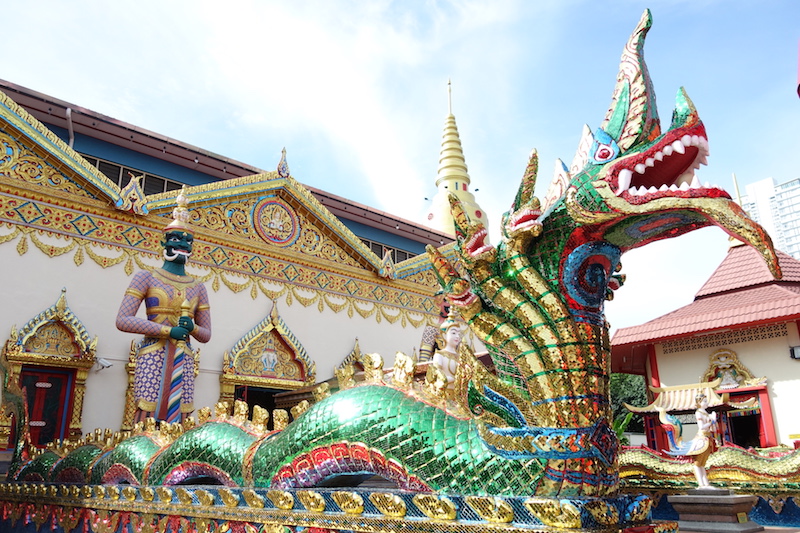 Outside Wat Chaiyamangalaram
Outside Wat Chaiyamangalaram
Wat Chaiyamangalaram - a Thai-style Buddhist shrine built in the 1950’s with a huge reclining Buddha. It had a pair of large dragons adorned with a mosaic of mirror pieces. Once we were in Thailand we would see this temple style repeated often.
 Reclining Buddha statue inside Wat Chaiyamangalaram
Reclining Buddha statue inside Wat Chaiyamangalaram
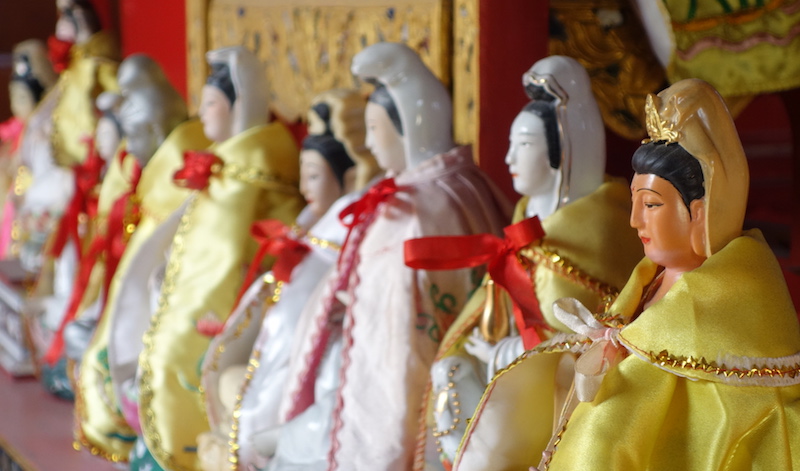 Devas figurines at Wat Chaiyamangalaram
Devas figurines at Wat Chaiyamangalaram
Just across the street was the Dhammikarama Burmese temple, over 200 years old and apparently the oldest Buddhist temple in Penang with large statues and fountains. The latest addition was the towering Golden Pagoda Bell Tower. Though quite compact, this temple complex was more extensive than its Thai counterpart, with fountains, fish ponds and several small buildings used by monks and other for functions unknown to us.
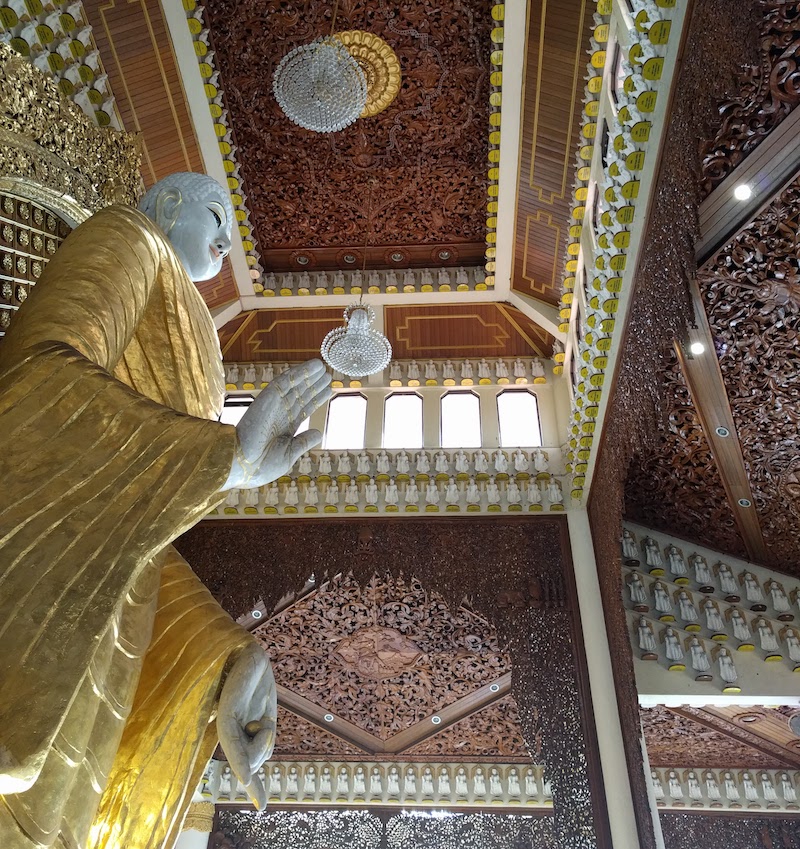 Dhammikarama Burmese Temple
Dhammikarama Burmese Temple